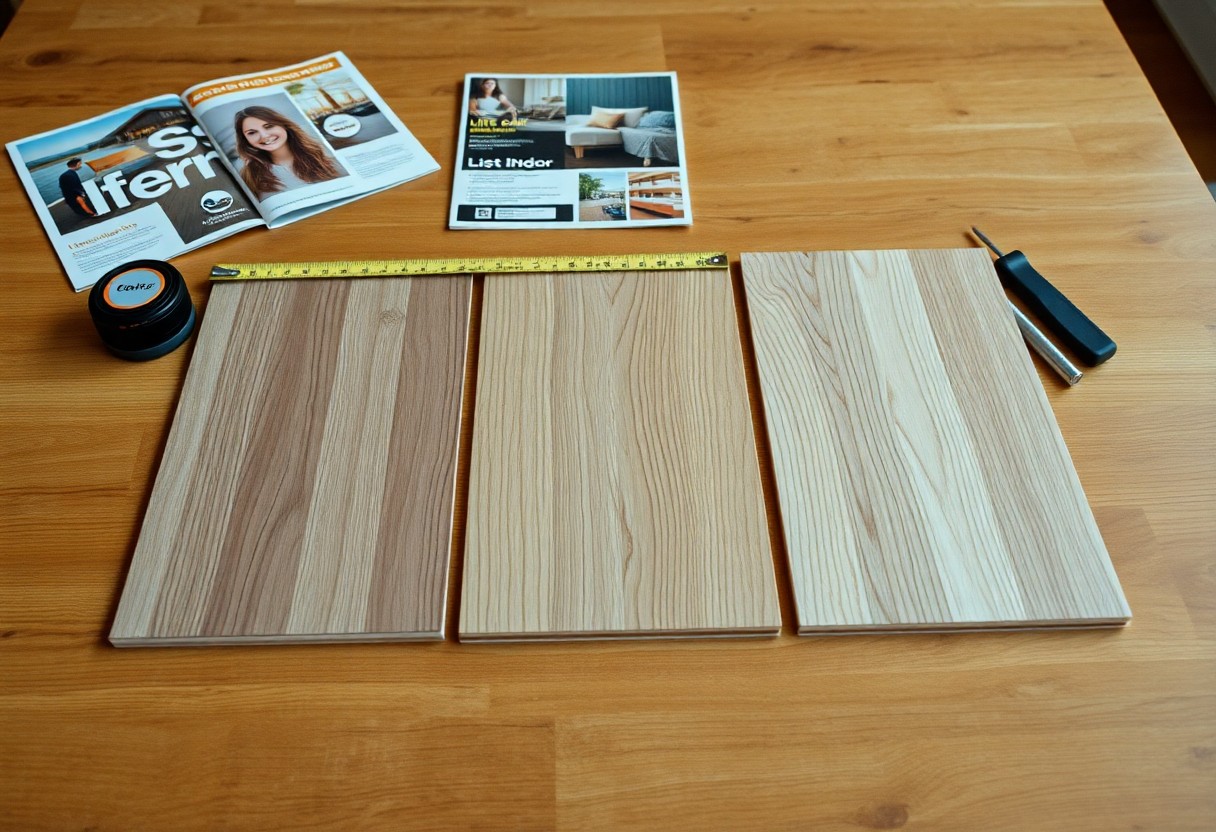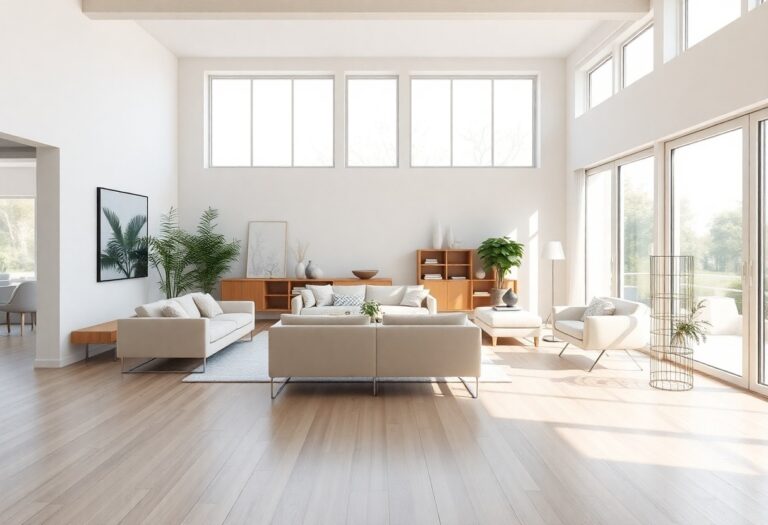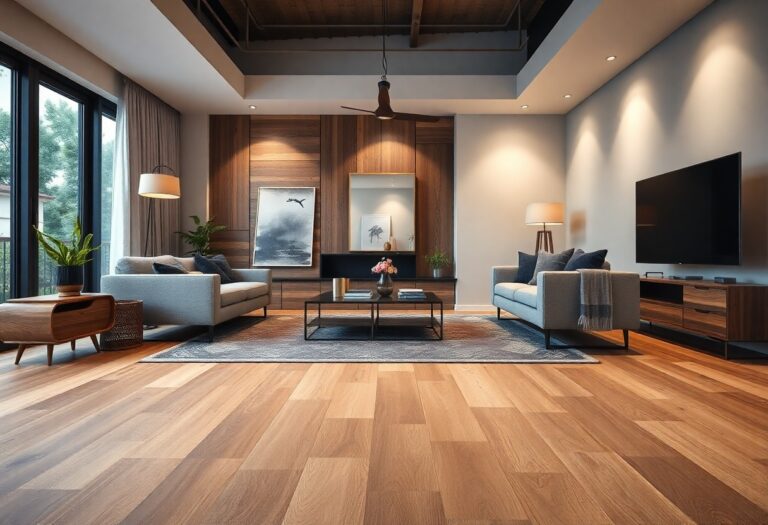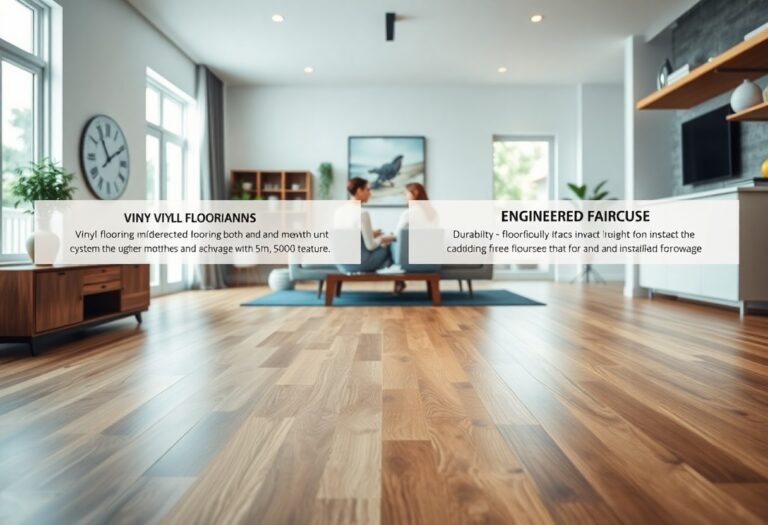Flooring choices can significantly impact both the aesthetics and functionality of your home. When deciding between laminate, white oak, or engineered flooring, it’s necessary to consider factors like durability, maintenance, and the specific demands of your lifestyle. This guide will help you evaluate each option so you can choose the flooring that best aligns with your needs and preferences, ensuring a beautiful and practical living space.
Understanding Flooring Options
Choosing the right flooring involves evaluating various materials, each offering distinct features that suit different lifestyles and preferences. You’ll want to consider durability, maintenance, aesthetics, and budget when exploring laminate, white oak, and engineered flooring. Each option brings unique qualities, making your choice crucial to achieving the perfect ambiance in your home.
Overview of Laminate Flooring
Laminate flooring is composed of several layers, including a high-density fiber core and a photographic layer that mimics natural wood. It’s a budget-friendly option known for its scratch and stain resistance, making it ideal for high-traffic areas. Installation is straightforward, often utilizing a click-lock mechanism that allows for DIY projects.
Exploration of White Oak Flooring
White oak flooring is favored for its durability and timeless appeal. This hardwood variety showcases a warm, natural grain and can be finished in various stains to match your décor. With a Janka hardness rating of 1360, it stands up to wear and tear, making it an excellent choice for both residential and commercial spaces.
In addition to its robustness, white oak’s versatility allows it to blend seamlessly with modern and traditional styles. The wood’s tight grain patterns create a sophisticated look, while its inherent resistance to moisture makes it suitable for kitchens and bathrooms. You can expect longevity and the ability to refinish multiple times, extending its lifespan even further.
Insights on Engineered Flooring
Engineered flooring consists of multiple layers of wood veneer over a plywood base, providing the aesthetic of solid wood with enhanced stability. It’s less prone to warping or buckling than traditional hardwood, making it a wise choice for fluctuating humidity levels. Engineered options can be installed over a variety of substrates and are available in various species and finishes.
This construction not only enhances durability but also allows for faster installation methods. With thicknesses ranging from 3mm to 7mm, engineered flooring can suit your specific needs and budget. Its ability to handle moisture makes it suitable for basements, and the versatility in design means you can achieve a high-end look at a lower cost than solid hardwood.
Factors to Consider
When opting for the perfect flooring for your space, various factors come into play. You must assess your lifestyle, environmental conditions, and aesthetic choices. Evaluate the following aspects:
- Your household size and activity level
- Maintenance requirements
- Exposure to moisture and temperature changes
- Design goals and existing decor
This holistic approach ensures you choose a flooring solution that fits seamlessly into your life.
Lifestyle and Usage Requirements
Your day-to-day activities significantly influence flooring choices. If you have pets or children, durability and scratch resistance become priorities. High-traffic areas benefit from materials like laminate or engineered flooring, while more serene spaces may afford the luxury of traditional hardwood. Assess your routines to align with reliable options.
Climate and Environmental Considerations
Climate plays a pivotal role in your flooring decision. Humid environments can warp natural wood, while arid conditions may cause cracks. Choose materials that can withstand local weather challenges, ensuring longevity and performance.
Consider your region’s humidity and temperature fluctuations. For areas with high moisture, engineered flooring typically performs better due to its layered structure. Conversely, in dry climates, avoid solid hardwood as it may expand and contract excessively. Emphasizing materials that balance well with your environmental factors ensures a lasting investment in your home.
Aesthetic Preferences and Design
Your unique style and home decor guide your flooring choice. From modern minimalism to rustic charm, flooring contributes significantly to your home’s ambiance. Laminate offers a vast range of finishes, while engineered wood showcases the beauty of natural grains.
Explore various colors and textures that resonate with your vision. Darker floors create drama, while lighter tones enhance openness. Consider the overall palette of your space and how the flooring integrates into it, as this choice can redefine your interior aesthetics, making it visually cohesive and inviting.
How to Choose the Best Flooring
Your choice of flooring should align with your specific needs and lifestyle. Begin by evaluating durability, maintenance, and budget constraints to find the best fit for your home. Each option offers unique advantages and understanding these can simplify your decision-making process.
Assessing Durability Needs
Consider how much foot traffic your flooring will endure. If you have pets or young children, you require materials that withstand wear and tear. Laminate flooring often excels here due to its scratch resistance, while engineered wood offers a balance of beauty and resilience ideal for moderately busy households.
Evaluating Maintenance Requirements
Your lifestyle will dictate the maintenance required for your flooring. Laminate is relatively low-maintenance, needing only occasional sweeping and mopping. Engineered wood requires specific cleaning products and timely refinishing, while solid hardwood needs regular upkeep to maintain its luster and can be more sensitive to humidity changes.
For example, if you lead a busy life with minimal time for upkeep, laminate flooring may be ideal, as it doesn’t require polishing or special cleaners. In contrast, if you prefer the rich appearance of wood and have time for routine maintenance, engineered or hardwood might be more suitable, but be ready to commit to scheduled care.
Considering Budget Constraints
Factoring in long-term costs, laminate may seem appealing initially, but consider potential replacements after a decade due to wear. Engineered wood, while pricier upfront, could provide a more durable and cost-effective solution over time given its longevity and ability to be refinished. Thus, it’s important to view flooring not just as an immediate expense but as an investment that impacts your home’s value and livability.
Tips for Installation
Proper installation is vital to ensure the longevity and performance of your flooring choice. Always follow the manufacturer’s guidelines, and consider the following tips for a flawless result:
- Acclimate your flooring materials before installation.
- Ensure the subfloor is clean, dry, and level.
- Use the necessary tools and materials for your specific flooring type.
- Plan the layout to minimize waste and optimize installation.
- Allow for expansion gaps around the perimeter.
Assume that taking these steps will significantly impact your flooring’s durability and aesthetics.
DIY vs. Professional Installation
Your choice between DIY and professional installation depends on your skill level, time commitment, and desired quality. If you have experience with home improvement tasks, DIY could be a cost-effective option. However, professional installers guarantee precision and can navigate complex scenarios that might arise during the process. Weigh the pros and cons based on your confidence in handling tools and the complexity of your flooring choice.
Preparing Your Space for Flooring
Preparation is key to a successful flooring installation. Start by clearing the area of furniture, debris, and old flooring materials. Ensure the space is well-ventilated, particularly if you’re using adhesives. It’s also wise to address any subfloor imperfections, such as filling in gaps or repairing damage, as these can affect the final look and performance of your new flooring.
Before installation, take the time to thoroughly prepare your space. This includes not only removing furniture but also checking for moisture issues, which can lead to problems later. Measure your area to determine the amount of flooring needed accurately, and make sure to check the manufacturer’s recommendations for any specific preparation requirements based on the flooring material you’ve chosen. A well-prepared space can mean the difference between a successful installation and frustration down the line.
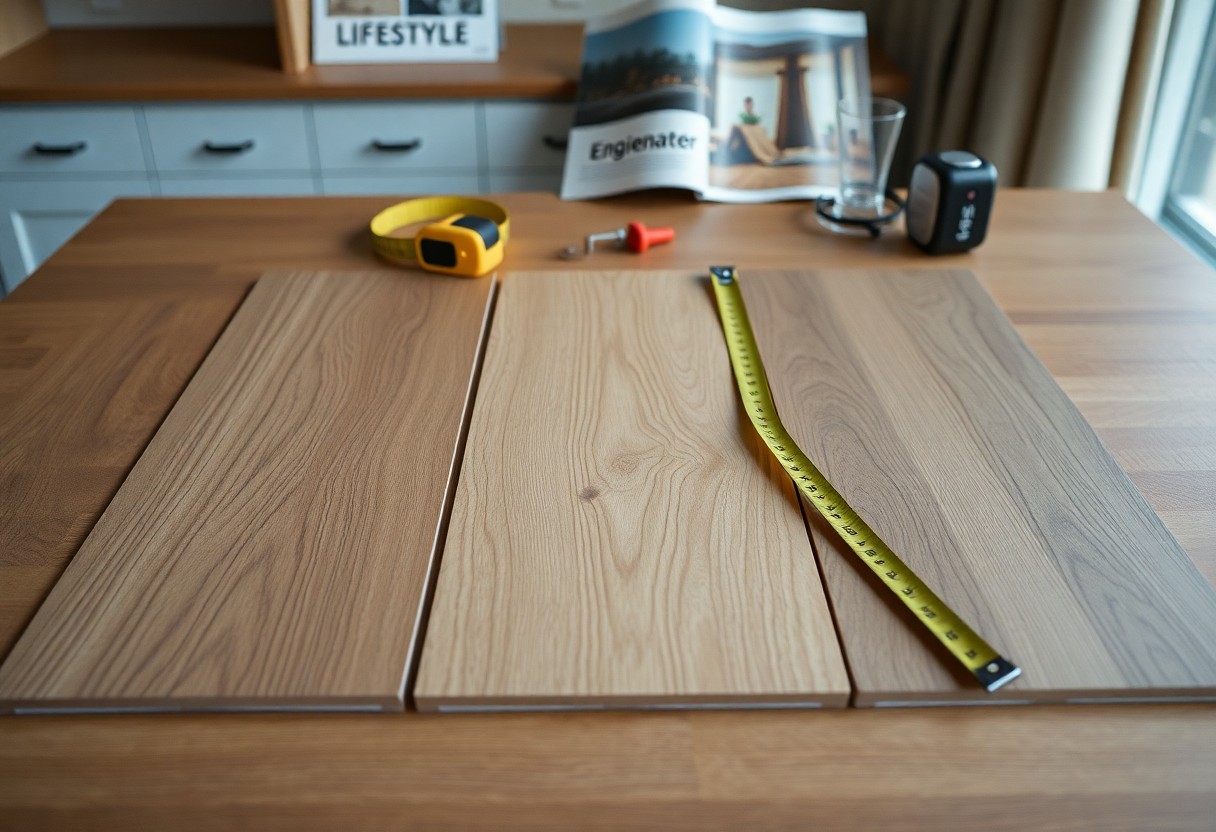
Maintenance and Care
Maintaining your flooring not only enhances its beauty but also prolongs its life. Each flooring type requires different care techniques to remain in optimal condition. Regular cleaning and appropriate care specific to your flooring material are necessary. This minimizes wear and tear, keeping your investment looking new for years.
Cleaning Guidelines for Different Flooring Types
Adhering to the correct cleaning methods for your flooring type is vital. Each material has its own needs:
| Flooring Type | Cleaning Method |
| Laminate | Use a damp mop and mild detergent. |
| White Oak | Clean with a wood floor cleaner or a damp cloth. |
| Engineered | Use a vacuum or soft broom followed by a damp mop. |
| General | Avoid harsh chemicals and excessive water. |
This adherence to care specifics can significantly impact the longevity of your floors.
Long-Term Care Tips
To ensure your flooring maintains its integrity over time, implement regular maintenance routines. This includes cleaning spills immediately, using protective pads under furniture, and periodically checking for signs of wear. Simple strategies can effectively preserve your flooring’s aesthetic and durability.
- Wipe up spills right away.
- Use mats at entryways to reduce dirt.
- Refinish hardwood floors every 3-5 years.
- Maintain humidity levels between 30-50%.
- Recognizing minor issues early can prevent costly repairs.
Keeping an eye on your flooring condition prevents extensive damage. Regular seasonal checks, combined with protective measures, can help to spot any developing issues early, ensuring your floors maintain their luster and stability.
- Inspect for scratches or dents regularly.
- Polish laminate floors to maintain sheen.
- Use area rugs in high-traffic zones.
- Schedule professional cleaning for tough stains.
- Recognizing these details will extend your floor’s lifespan.
Comparing Costs
Cost Breakdown of Each Flooring Option
When evaluating flooring, understanding the costs can significantly influence your decision. Below is a clear comparison:
| Flooring Option | Average Cost per Square Foot |
|---|---|
| Laminate | $1.50 – $5.00 |
| White Oak | $5.00 – $10.00 |
| Engineered Flooring | $3.00 – $7.00 |
Evaluating the Long-Term Value
Long-term value involves assessing not just the initial cost but also how the flooring withstands wear and retains its aesthetic appeal over time. Choosing a more expensive option like white oak may provide superior durability and resale value.
For instance, white oak floors, while higher in upfront costs, often last for decades with proper care, enhancing your home’s value. Laminate, although budget-friendly initially, may need replacement sooner due to wear, affecting its cost-effectiveness. Engineered flooring strikes a balance, providing a durable surface at a mid-range price, and can be refinished to extend its life. Balancing your lifestyle, potential household traffic, and maintenance can help you determine which option delivers the best long-term investment for your home.
To wrap up
Hence, when choosing between laminate, white oak, or engineered flooring, consider your specific lifestyle needs, aesthetic preferences, and budget. Each option offers distinct benefits, from laminate’s affordability and durability to white oak’s timeless beauty and engineered flooring’s versatility. Assess the level of foot traffic in your space, moisture exposure, and ease of maintenance to make an informed decision that enhances your home while aligning with your daily activities.


